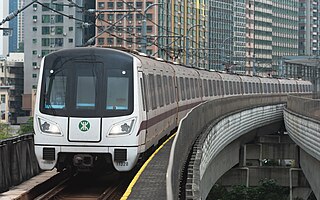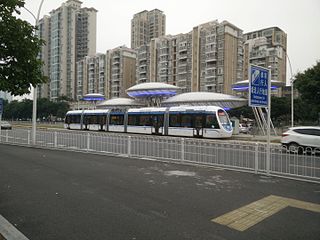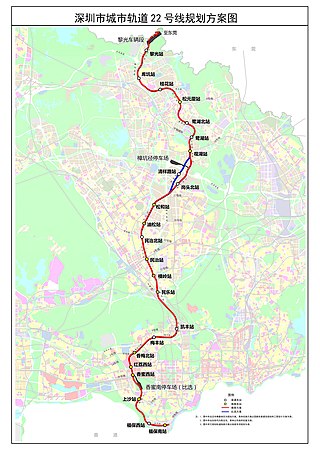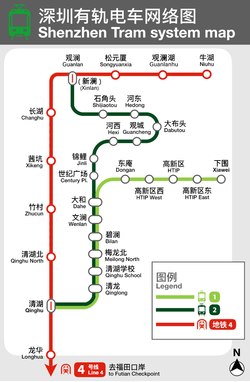
The Shenzhen Metro (深圳地铁) is the rapid transit system for the city of Shenzhen in Guangdong province, China. The Line 8 Extension – which opened on December 27, 2023 – put the network at 555.43 kilometres of trackage. It currently operates on 16 lines with 373 stations. Despite having only opened on December 28, 2004, the Shenzhen Metro is the 5th longest metro system in China and 6th longest in the world. By 2035, the network is planned to comprise 8 express and 24 non-express lines totaling 1,142 kilometres of trackage.

Bao'an District is one of the nine districts comprising the city of Shenzhen, Guangdong province. It is one of the districts formerly lying outside the Shenzhen Special Economic Zone.

Urban rail transit in China encompasses a broad range of urban and suburban electric passenger rail mass transit systems including subway, light rail, tram and maglev. Some classifications also include non-rail bus rapid transport.

Shenzhenbei Railway Station is one of the four large intercity railway stations of Shenzhen, located in Longhua District. It has 11 platforms and 20 lines. It is an interchange station between the Guangzhou–Shenzhen–Hong Kong Express Rail Link, the Hangzhou–Fuzhou–Shenzhen High-Speed Railway, future Shenzhen–Zhanjiang high-speed railway and the Shenzhen Metro Lines 4, 5 and 6. Construction started in 2007 and was completed in June 2011. The Line 4 and Line 5 platforms opened on 22 June 2011, CRH platforms opened on 26 December 2011 and Line 6 platforms opened on 18 August 2020.

Line 16 is a rapid transit line serving the south-eastern suburban areas of Shanghai. The line was formerly known as the Lingang line. It was originally designated as Line 21 and was planned as the south part of line 11. The line runs entirely in Pudong New Area, starting from Longyang Road, via Shanghai Wild Animal Park, Huinan Town, ending at Dishui Lake in Nanhui New City. The line is 59 km (37 mi) long and has 13 stations of which three are underground and the rest elevated. Construction begun in early 2009, and the line opened on 29 December 2013. The second phase was completed at the end of 2014.

Line 4 of the Shenzhen Metro, formerly branded as the Longhua line, runs South–North from Futian Checkpoint to Niuhu. The line serves Futian District and Longhua District of Shenzhen.

Xi'erqi station is an interchange train station between Line 13 and the Changping Line on the Beijing Subway. The station has relocated to a new location several hundreds meters north on December 25, 2010 to ease transfer between the two lines when the new Changping Line opened, and the original station was then defunct, but was not demolished until August 2020. The new building a light membrane white covering was designed by Atelier Li Xinggang. The station is extremely congested with 13,000 people per hour transferring between the station's two lines during peak periods. A viral video filmed at this station showing rush hour crowds attempting to board the overcrowded trains was posted on YouTube in 2013.

Shenzhen Pingshan railway station is a high-speed railway station on the Xiamen–Shenzhen Railway. The station is located in the Pingshan District of Shenzhen City, Guangdong Province, China. The station opened to the public on 28 December 2013.

Shenzhen Metro Line 5, runs West–East from Chiwan to Huangbeiling forming an arc around central Shenzhen. It opened on 22 June 2011. Line 5's color is purple. Line 5 is an important east west and orbital line that connects various sub-centers of Shenzhen. This led to Line 5 being heavily used. In 2014, average daily ridership exceeded 500,000 people, with over 1 million passengers using the line on 20 July 2018, setting a new record. Since 2019, Line 5 has surpassed Line 1 as the busiest line in the Shenzhen Metro network. By 2021, the line regularly carries well over 1 million passengers every day and reaching the predicted long term daily passenger volume.

Line 6, also known as the Guangming line of the Shenzhen Metro is in operation. Line 6 is part of the Phase III expansion of the Shenzhen Metro with a construction time frame scheduled for 2015–2019.

Shenzhen Metro Line 11 opened on 28 June 2016. Line 11 has a length of 53.5 km (33.2 mi) and a total of 19 stations. It connects the CBDs of Futian, Nanshan and Qianhai to Shenzhen Bao'an International Airport and onward to Fuyong, Shajing and Songgang suburban areas. It serves as both a regional express line from the west coast of Shenzhen to the city core area and an airport rail link. Compared with the other lines of Shenzhen Metro, Line 11 has a longer spacing between stops for a higher speed service. Trains of Line 11 were designed to run at 120 km/h (75 mph), up to 50% faster than other lines, but currently limited to 80 km/h (50 mph) in some sections for infrastructure, tunnel wind pressure, track geometry issues and noise reasons. Construction of Line 11 started in April 2012 and test running begun at the end of March 2016. Trains run at a 4-minute frequency between Futian and Airport North, 8-minute frequency for full length trains during morning rush hours, 5-minute interval for full length during evening rush hours, and 6-minute interval for non-peak hours. Currently it takes slightly more than half an hour to travel from Futian to the Airport. Line 11's color is violet.

Longhua District is a district in Shenzhen, Guangdong, People's Republic of China. It was created as a new district on 30 December 2011, and became a formal district on 11 October 2016.

Several cities in China had tram systems during the 20th century; however, by the end of the century, only Dalian and Changchun remained extant. However the 21st century has seen a resurgence in tram transport systems as China attempts to combat with urban traffic congestion and pollution.

The Zhuhai tram network was a light rail system serving the city of Zhuhai, Guangdong, China. The first section of Line 1 started trial operation on November 7, 2014 with the full line scheduled initially to open by August 2015 and finally opened on 13 June 2017 and runs from Haitian Gardens to Shangchong. However, facing the problems of frequent breakdowns and low passenger flow, the operation of Zhuhai Tram Line 1 was never carried out smoothly and the Government decided to stop its operation in January 2021 and then to dismantle it in May 2024.

Shenzhen has an extensive transport network, including various forms of land, water and air transport.
Tianshui Tram is a light rail system consisting of one route in Qinzhou District and Maiji District, Tianshui, Gansu, China.

Shanghai Rail Transit includes all rail transit lines operating in Shanghai, mainly composed of High-volume railway system, Low-to-medium-volume railway system and Maglev system. The system was established on May 28, 1993, when Shanghai Metro Line 1 opened.

Line 22 of the Shenzhen Metro is an express line under construction, which will connect the districts of Futian, Longhua and Longgang for 38 kilometers and 23 stations. Construction began on 2 January 2024, and the line is expected to open in March 2029. The first phase of Line 22 will run from Shangsha in Futian District to Liguang in Longhua District, with 21 stations and 34.2 kilometers of track. The line is proposed to use 6 car type A trains. It is proposed to extend into Dongguan in long term planning.
Line 21 of the Shenzhen Metro is an express line under planning, which will connect across Shenzhen through the districts of Nanshan, Longhua and Longgang for 66 kilometers and 26 stations. The first phase of Line 21 originally entered Phase V planning in September 2022, and will run from Aobei to Longyuan in Longgang District, with 6 stations and 12.5 kilometers of track, however planning has been put on hold since 31 March 2023. The line is proposed to use 8 car type A trains.





















